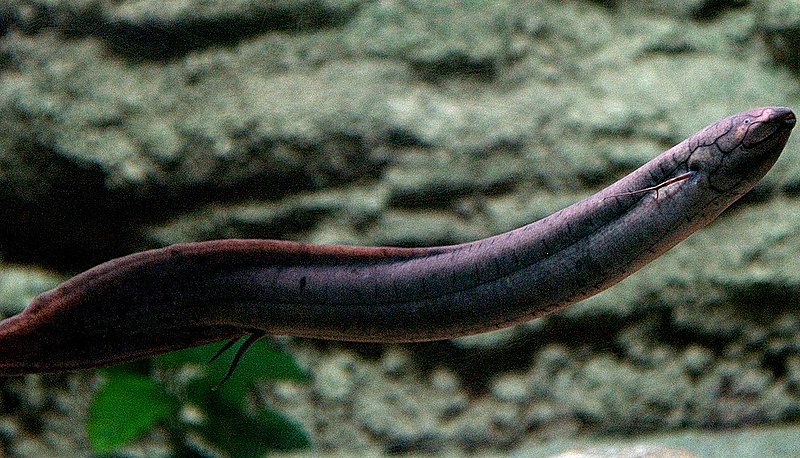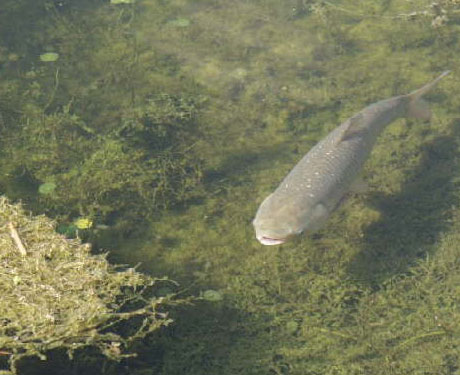In the 1970s Asian carp (referring to bighead, silver,
black, and grass carp) were imported to the U.S. to filter ponds in Arkansas. Flooding
allowed them to escape and breed in the wild by the early 1980s. They have been
steadily moving north and are now dangerously near our Great Lakes. In 2007,
all silver carp were officially declared to be an invasive species. These carp
are in competition with our native species and due to their feeding strategies (they
don’t eat worms or other fish) are difficult to catch using traditional
methods.
Asian carp, silver carp in particular, are best known for
their tendency to jump out of the water when startled. In China, this became a
symbol of the sudden rise in social status that comes from success in the
imperial examination. However in the U.S., these fish inspire very different
feelings.
As Asian carp can grow to be 100lb and can jump 8 to 10 feet
into the air they have been known to cause problems. There have been instances
of boaters being injured by flying carp, a woman broke her nose and a vertebra
and an inner tuber’s jaw was broken by colliding with one of these carp.
These fish are a danger to us all and good old American ingenuity has come to the rescue.
A Living Fossil: The Lungfish
Watch this video first, it will give you a good introduction to the lungfish.
First things first, sorry about this but I love phylogeny trees. I think they are one of the greatest things ever invented and are super fun to look through. If you don't know what that is or if you've never seen one, this is a phylogenetic tree for lungfish, it can also be called an evolutionary tree if you prefer that.
,--Family Diabolichthyidae (extinct) | ,--Family Uranolophidae (extinct) | | __,--Family Speonesydrionidae (extinct) '-|-| '--Family Dipnorhynchidae (extinct) | ,--Family Stomiahykidae (extinct) '----|___ ,--Family Chirodipteridae (extinct) | '-|--Family Holodontidae (extinct) |------Family Dipteridae (extinct) | __,--Family Fleurantiidae (extinct) '-| '--Family Rhynchodipteridae (extinct) '--Family Phaneropleuridae (extinct) | ,--Family Ctenodontidae (extinct) '-| ,--Family Sagenodontidae (extinct) '-|--Family Gnathorhizidae (extinct) '--Order Ceratodontiformes |--family Asiatoceratodontidae (extinct) |--Family Ptychoceratodontidae (extinct) |--Family Ceratodontidae | '--Genus Ceratodus (extinct) | '--Genus Metaceratodus (extinct) '--Family Neoceratodontidae | '--Genus Mioceratodus (extinct) | '--Genus Neoceratodus - Queensland lungfish '--Order Lepidosireniformes '--Family Lepidosirenidae - South American lungfish '--Family Protopteridae - African lungfish
As can be seen from the phylogenetic tree, the Queensland, or Australian, lungfish is the only surviving member of its order and family, while the South American lungfish and the African lungfish are of the same order and therefore more closely related. There are only six surviving species of lungfish; one Australian, one South American and four African.
From the fossil records it can be assumed that some form of lungfish has been around for at least 380 million years, since before the formation and subsequent breakup of the supercontinent Pangaea.
 |
| The supercontinent Pangaea, 300 million years ago |
Lungfish fossils have been found in Australia that are nearly identical to the current Queensland lungfish species which means that this genus of lungfish has remained virtually unchanged for over 100 million years. The Queensland lungfish is considered to be a living fossil and is one of the oldest living vertebrate genera in the world.
 |
| Australian lungfish, or Queensland lungfish Note the flipper-like fins |
The six species of lungfish come in various sizes, the smallest species being about 2 feet long and the largest reaching 6.6 feet. They are also long-lived animals, a Queensland lungfish in a Chicago aquarium is at least 80 years old and has been there since 1933.
 |
| A South American lungfish Note the string-like fins rather the Queensland's flipper-like fins |
The fins on all lungfish are also special, unlike most fish whose fins have a limited range of motion the joints that attach these fins are similar to a tetrapod's joints. Tetrapods being four-limbed terrestrial animals.
 |
| A Marbled lungfish, one of the four African species These fins are long and flat but not really flipper-like |
One last thing I will mention about these fish because it is rather amazing, the Marbled lungfish, as seen above, has the largest known genome of any vertebrate on the planet at 130 billion base pairs.

No comments:
Post a Comment